The functional purpose of the shelves in everyday life is the placement of various objects: large, heavy or decorative, fragile. The choice in their favor is made if the installation of furniture elements is undesirable for design reasons. The use of wall-mounted shelves in the interior allows you to create a feeling of lightness of space - to expand its visual perception. Although at the same time they perform a very specific bearing function.
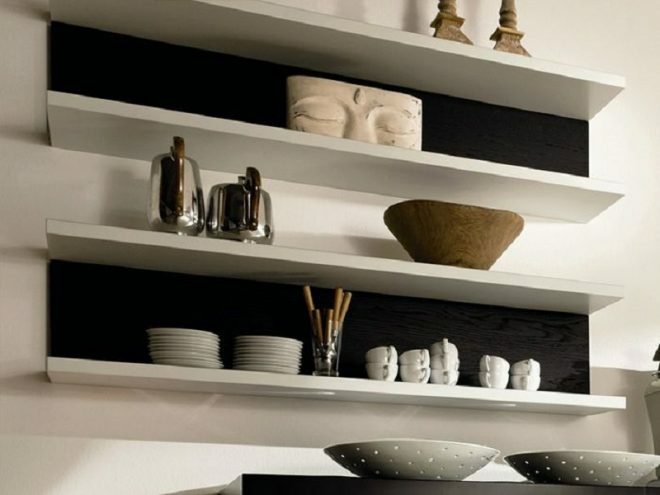
Therefore, it is important that each shelf is securely fixed, taking into account the strength of the wall (whether it is a wall brick, concrete, plasterboard partition or wooden wall), its material and the planned load. Then the question arises of choosing a method of fastening, which is determined depending on several factors:
Attention! Earned on our website kitchen designer. You can familiarize yourself with it and design your dream kitchen for free! May also come in handy wardrobes designer.
- Using the shelf as an element of the interior,
- Manufacturing material,
- Functional purpose (load for which it is designed),
- The strength of the surface of the wall or partition to which it will be attached.
Consider the possible types of fasteners and their choice depending on the style of interior decoration.
Types of fasteners
Hidden
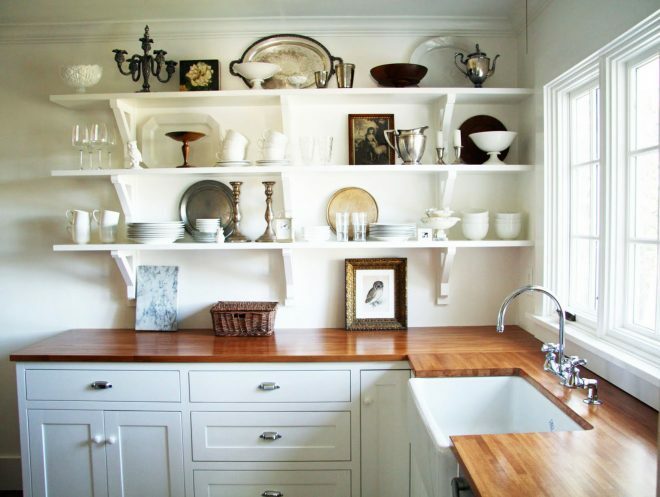
The choice of hidden shelf mounting is usually determined by the style of the room. Since this method is quite laborious, preference is given to it only in case of urgent need. This type of installation creates a feeling of lightness of construction, expansion of the space of the room. It is often used as an element of interior design in the style of minimalism, ethnic Asian (Japanese, Chinese, Thai), modern, hi-tech.
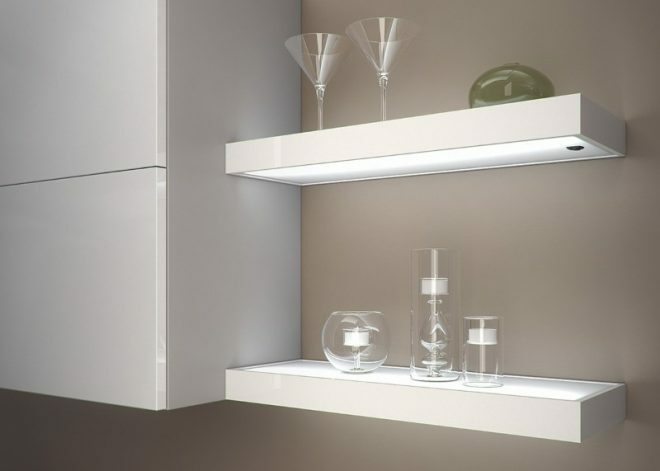
Concealed hinges
They can be used for wooden shelves, laminated chipboard, plywood. The hinges are attached to the back of the shelf with self-tapping screws according to the markings. If this is a home-made product, then it is better to make recesses (cuts) at the points of attachment of the loops the size and thickness of the fastening hardware, so that the hinges are flush with the edge of the product and tightly adjoin the wall. Now it can be hung on the wall, on the screws pre-screwed into it.
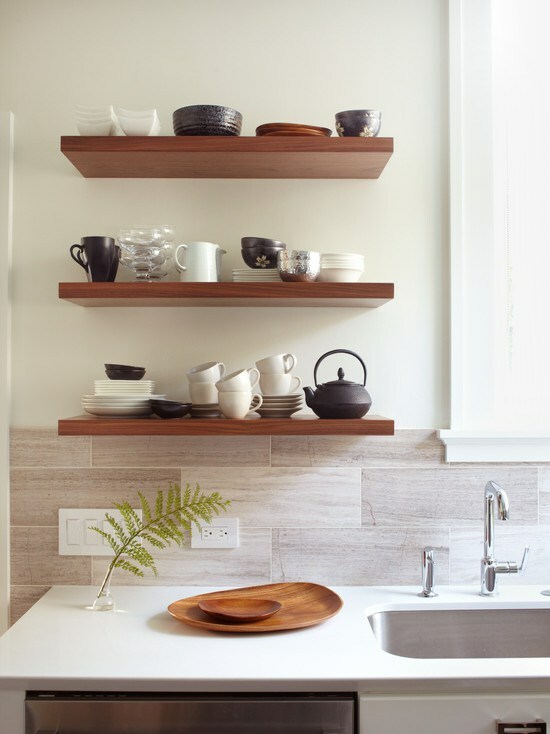
Cantilever mount
There are several types of mounting parts to consider in this section:
Metal rods
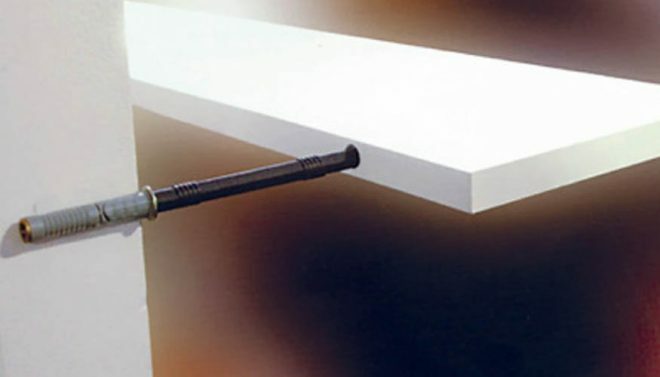
Now on the market there is a large selection of console mountings, complete with them you can pick up ready-made shelves of various sizes. The design includes a hidden mens holder for a wooden shelf, a bracket for attaching the mens holder to the wall.
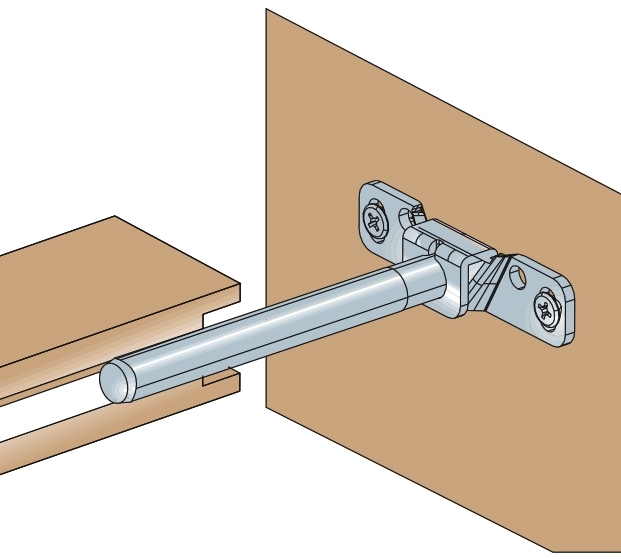
This method provides for the presence of holes in the shelf into which metal rods of furniture fittings will be inserted, while the rod should be 2-5 cm shorter than the product itself.
At home, you can design a similar console mount yourself, using as metal rods, pieces of reinforcement, threaded rods complete with driven anchors. And in the shelf itself, you need to drill holes in the size corresponding to the rods, observing the rule that they should be at least 2-5 cm shorter than the width of the product. In this case, the thickness of the rods ranges from 10 to 18 mm, depending on the weight of the future filling.
Wooden bars
This method of fastening includes mounting a frame made of wooden blocks, most often square, on the wall. or rectangular section, and then stringing a shelf on them, which is a hollow structure (box). For reliability, the parts are fixed with self-tapping screws; additionally, the elements can be put on glue.

Brackets, fasteners, corners
When choosing fastening with brackets, it must be borne in mind that the fasteners will always be in sight. And this method may well become a decorative element in the interior.
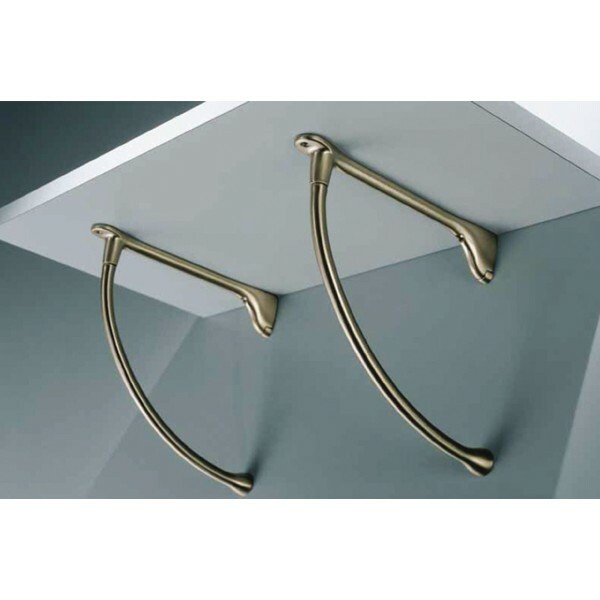
After all, there is a wide variety of forms, styles, materials for the manufacture of brackets. That is why shelves on brackets are used in interiors of classic, rustic, modern styles, modern, shabby chic, loft and other styles.

The choice in favor of such fasteners can be made not only because of their decorative appeal, they can provide reliability under a significant load - up to 30-50 kg.
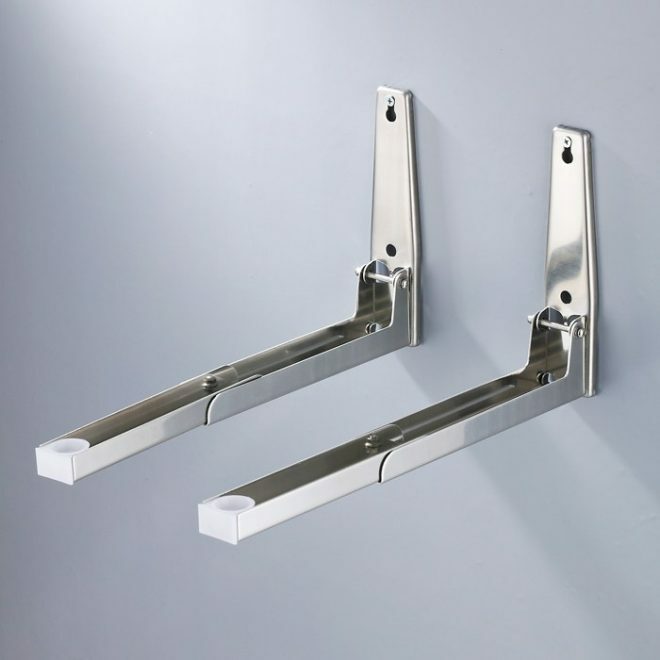
The models and designs of the brackets, the materials of their manufacture and the materials of the shelves, for which they can be used, are quite diverse. Therefore, it will not be possible to give generalized recommendations on how to attach them to them.
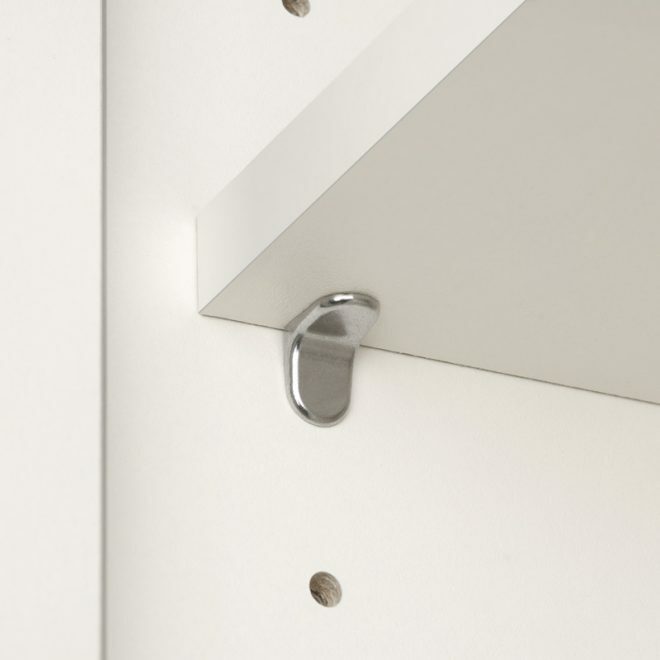
But recommendations for mounting shelves on brackets on the wall will be given below.
Fastening glass shelves
Although the method of attaching glass shelves is a kind of fastening with brackets, we will consider it as a separate issue. After all, the material for making such products allows you to achieve interesting decorative effects.
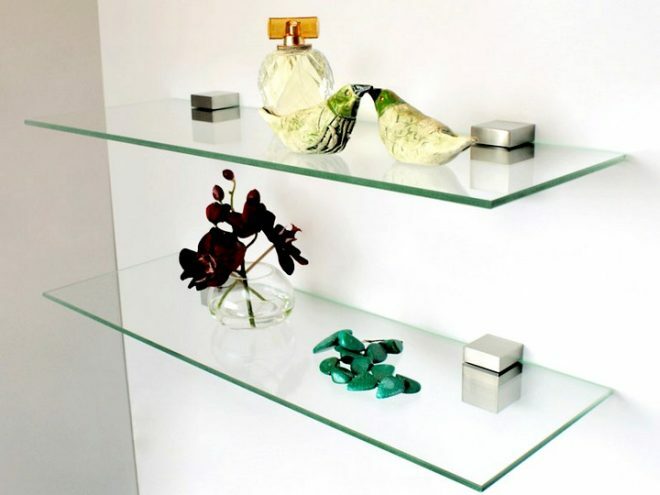
Glass products can be:
- Thin or thick (manufacturers market models with a thickness of 4 to 12 mm).
- Triplex shelves with fogging between the layers of the design elements (they have a significant dead weight).
- Transparent and matte.
- Made of colored or black glass.
- Stained glass shelves.
- Frosted glass with LED backlighting (can be an independent decorative element in the interior).
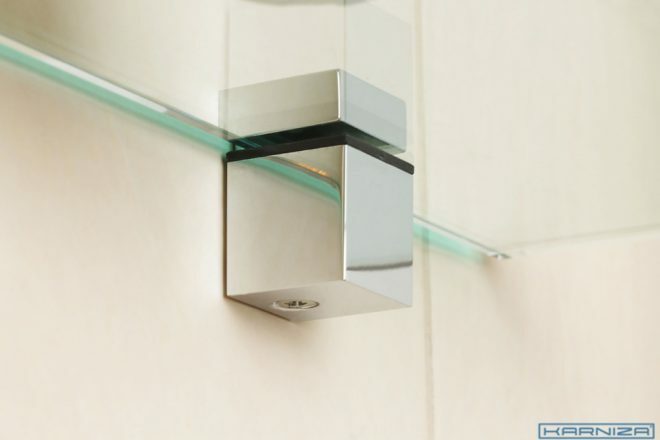
Brackets for glass shelves are offered by design and size:
- Minimum dimensions for small and lightweight shelves.
- Large brackets, so called pelicans.
- Brackets with suction cups (bottom only), which makes the top surface of the shelf open.
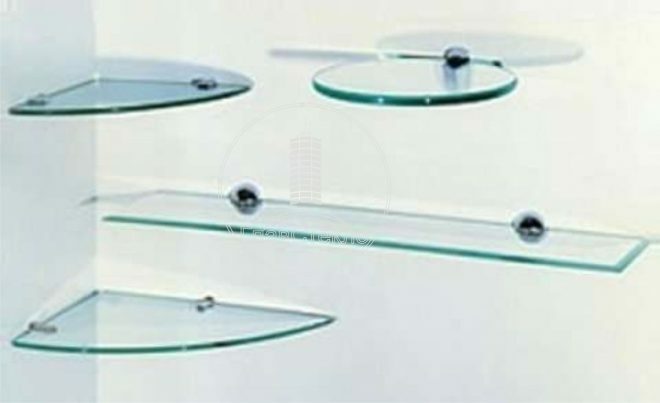
Since glass is a fragile material, this is taken into account in the design of the mounting brackets - they use silicone or rubber gaskets to protect the surface of the shelves both from above and below
Shelf fixing rules and necessary tools
Tools
- Pencil or marker;
- Building level;
- Roulette or ruler;
- Drill or hammer drill (depending on the type of wall);
- Screwdriver or screwdriver;
- Mallet, better rubber.
Installation rules
The main and general condition for the reliability of the fixed shelf is the correct calculation of the reliability of the fastening, depending on the planned load. The longer and the greater its mass with potential filling, the more points of support (metal rods, wooden bars or hinges) should be.
To correctly fix the prepared shelf on the wall in the intended place, the following rules must be observed:
- Make orientation markings using a building level, which will ensure a strictly horizontal position of the shelf. Mark a horizontal line on the wall with a pencil or marker;
- Using a tape measure, mark the places for fastening the screws. To do this, measure the distance between the centers of the holes of the hidden hinged hinges, the centers of the brackets, corners. Mark this distance on the already drawn horizontal line.
- In these places, drill holes corresponding in diameter and length to the dowels and screws selected in the kit. To do this, you need to choose the right drill size. Then drive dowels into the drilled holes with a mallet and screw in the screws as an independent suspension (in the case of using hidden hinges) or securing fittings (metal rods or brackets).
- Now you can safely hang the shelf! If at the same time it is necessary to use additional fasteners with self-tapping screws or glue according to the technology, it is important not to forget.
Features of mounting shelves depending on the type of wall
Concrete wall
The nuance of working in a room with concrete walls is the choice of drilling tools and drills. It should be a hammer drill and a special concrete drill made of hard alloys. The size of the drill, its diameter and length, are selected depending on the specific fastening accessories.
Plasterboard wall
If you plan to hang a shelf on a plasterboard wall that plays a decorative role (for souvenirs, figurines or vases), then you can safely use the TNF / -W butterfly dowel for its installation.
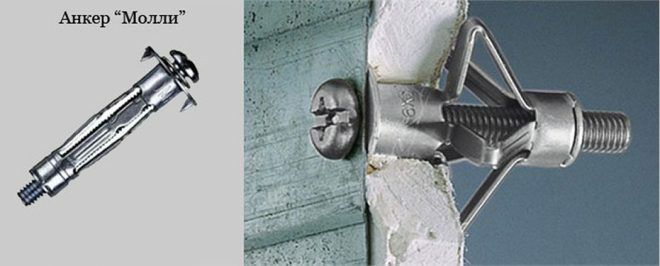
To fix it in drywall, you need to drill a hole of the appropriate size, drive a dowel into it. When screwing a self-tapping screw into such a dowel, it opens itself, forming a reliable stop in the drywall sheet, and a special cuff on the dowel does not allow it to rotate. Fastening a light shelf made of glass, thin plywood or other lightweight material in this way will be quite reliable.
For the installation of more weighty shelves, more laborious work will have to be done. At the stage of designing plasterboard partitions, in the places of the planned fastening of the shelves, it is necessary to install additional transverse aluminum profiles or bars of the corresponding section. It is in them in the future through drywall that holes will be drilled, dowels are installed and brackets are attached.
If at the stage of designing drywall walls such additional structures were not provided, then a way out can be found. Already on the outside of the plasterboard partition, you can fix the transverse bar on the vertical profiles located inside plasterboard partitions (in this case, their location must be known or determined, for example, by tapping or more technological methods). But in this case, the main task will be to make the bar invisible - for example, by hanging one long or several shelves in a row along the entire length of the bar. Or make it a decorative element.
Only some of the widespread and most common methods of fixing shelves in rooms have been described here. In addition to them, the imagination and experience of everyone can suggest other devices, designs and design solutions.
average rating 0 / 5. Number of ratings: 0
No ratings yet. Be the first to rate.


